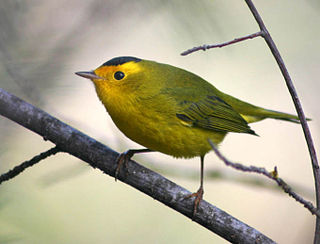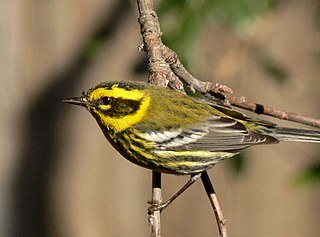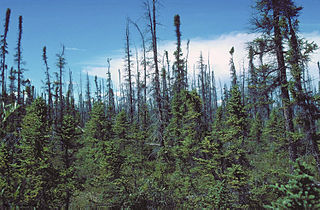
The New World warblers or wood-warblers are a group of small, often colorful, passerine birds that make up the family Parulidae and are restricted to the New World. They are not closely related to Old World warblers or Australian warblers. Most are arboreal, but some, like the ovenbird and the two waterthrushes, are primarily terrestrial. Most members of this family are insectivores.

The yellow-rumped warbler is a regular North American bird species that can be commonly observed all across the continent. Its extensive distribution range connects both the Pacific and Atlantic coasts of the U.S. as well as Canada and Central America, with the population concentrating in the continent's northern parts during the breeding season and migrating southwards to southern North and Central America in Winter. The species generally prefers coniferous forests or mixed coniferous-deciduous forests as its breeding habitat, while during the winter it can be found inhabiting more open areas such as shrublands that offer food resources. The diet of the yellow-rumped warbler is based primarily on insects, though the species does eat fruits such as juniper berries as well, especially in winter.

Audubon's warbler is a small bird of the Parulidae family.

The Blackburnian warbler is a small New World warbler. They breed in eastern North America, from southern Canada, westwards to the southern Canadian Prairies, the Great Lakes region and New England, to North Carolina.

The blackpoll warbler is a New World warbler. Breeding males are mostly black and white. They have a prominent black cap, white cheeks and white wing bars. The blackpoll breeds in forests of northern North America, from Alaska throughout most of Canada, to the mountains of New York and New England. They are a common migrant through much of North America. Come fall, they fly South to the Greater Antilles and the Northeastern coasts of South America in a non-stop long-distance migration over open water, averaging 2500 km, one of the longest distance non-stop overwater flights ever recorded for a migratory songbird. Rare vagrants to western Europe, they are one of the more frequent transatlantic passerine wanderers.

The magnolia warbler is a member of the wood warbler family Parulidae.

Wilson's warbler is a small New World warbler. It is greenish above and yellow below, with rounded wings and a long, slim tail. The male has a black crown patch; depending on the subspecies, that mark is reduced or absent in the female. It breeds across Canada and south through the western United States, and winters from Mexico south through much of Central America. It is a very rare vagrant to western Europe.

The hooded warbler is a New World warbler. It breeds in eastern North America and across the eastern United States and into southernmost Canada (Ontario). It is migratory, wintering in Central America and the West Indies. Hooded warblers are very rare vagrants to western Europe.

The Canada warbler is a small boreal songbird of the New World warbler family (Parulidae). It summers in Canada and northeastern United States and winters in northern South America.

Townsend's warbler is a small songbird of the New World warbler family.

Parula was formerly a small genus of New World warblers which breed in North and South America.

The elfin woods warbler is a species of bird endemic to Puerto Rico, where it is local and uncommon. Discovered in 1968 and described in 1972, it is the most recently described New World warbler.

Setophaga is a genus of birds of the New World warbler family Parulidae. It contains at least 33 species. The males in breeding plumage are often highly colorful. The Setophaga warblers are an example of adaptive radiation with the various species using different feeding techniques and often feeding in different parts of the same tree.

The red warbler is a small passerine bird of the New World warbler family Parulidae endemic to the highlands of Mexico, north of the Isthmus of Tehuantepec. It is closely related to, and forms a superspecies with, the pink-headed warbler of southern Mexico and Guatemala. There are three subspecies, found in disjunct populations, which differ primarily in the color of their ear patch and in the brightness and tone of their body plumage. The adult is bright red, with a white or gray ear patch, depending on the subspecies; young birds are pinkish-brown, with a whitish ear patch and two pale wingbars.

The pink-headed warbler is a small passerine bird found in the southwestern highlands of Guatemala and the central and southeastern highlands of the Mexican state of Chiapas. The adult is primarily red, with a silvery-pink head and chest. It is a fairly common to common resident of humid to semi-humid pine-oak, pine-evergreen and evergreen forest and edge, at altitudes ranging from 1,800–3,500 m (5,900–11,500 ft) above sea level.

The boreal forest or taiga of the North American continent stretches through a majority of Canada and most of central Alaska, extending spottily into the beginning of the Rocky Mountain range in Northern Montana and into New England and the Adirondack Mountains of New York. This habitat extends as far north as the tree line and discontinues in mixed deciduous-coniferous forests to the south. The "taiga", as it is called there, of Eurasia occupies a similar range on those continents. Throughout the Northern Hemisphere, the boreal forest covers 2.3 million square miles, a larger area than the remaining Brazilian Amazon rain forest. Although it is largely forest, the boreal forests include a network of lakes, river valleys, wetlands, peat lands and semi-open tundra.

Ergaticus was a genus of New World warblers — small passerine birds found only in the Americas. It was subsumed into Cardellina in 2011. The name is the Latinized version of the Ancient Greek ergatikos, meaning "willing or able to work". The genus contains two sister species: the red warbler, which is endemic to the Mexican highlands north of the Isthmus of Tehuantepec, and the pink-headed warbler, which is found south of the Isthmus, from the highlands of Chiapas, Mexico down into Guatemala. Though they are separated by geography and differ considerably in plumage, the two have sometimes been considered to be conspecific.
















